Thursday, July 24, 2008
Slow Summer Posting
Wednesday, July 23, 2008
Chaotic Bodies: The Firemen's Ball Beauty Pageant (part 1)
For this reason, I wanted to do a close analysis of the beauty pageant scene, breaking it down shot by shot in order to discuss what Forman is doing here. My starting and ending points within the scene are fairly arbitrary: I start after the first contestant runs off, sparking the riot, and cut off slightly before the sequence's true end when the firemen hear the siren going off in the midst of the disorder. In between is one of the film's most rapidly edited and frantically paced sections, a masterpiece of madcap comedy where everyone looks like they're having a blast just filming it. I've broken this down by taking a single screen capture from each shot in this segment, in order to illustrate the ways in which Forman's seemingly unhinged depiction of the chaos at this party is actually built up from a meticulous sense of editing rhythms and an eye for striking compositions even within a frenzied environment.
The first shot of this sequence is a cut back to the main room after a (very funny) brief scene upstairs, where one of the committee members was attempting, in vain, to catch two of the contestants as they fled into the ladies' room. This shot introduces the more frenzied section of the scene, as the main ballroom degenerates into total chaos and the guys attempt to drag girls kicking and screaming onto the stage for the beauty contest. I've only selected one screen capture per shot here to keep this from being too long a post, but each of these individual shots changes quite a lot from one frame to the next, with the camera frequently swinging along to follow the actors in their rapid motion. These shots seldom settle into static compositions, but I think even these single frame grabs provide a sense of the movement and energy of this scene.

In contrast to the chaos of the party itself, the periodic shots of the announcers on stage are very static and stylized. Throughout the film, Forman maintains a rigid distinction between the way he films the brigade leadership (who represent the Politburo) and the people at the party (the proletariat). As in this shot, the committee members are inevitably presented with a somewhat distanced, formal quality that makes them seem especially absurd in the context of all the disorder surrounding them. Throughout this scene, in particular, the periodic shots of the announcers are islands of stability in a shifting sea. But this stasis does not have a positive connotation in any way. They are static, not because they are stable, but because they are helpless, paralyzed by the complete loss of control over what's happening. Forman is much more sympathetic to the wild partygoers who embrace anarchy as a response to their inept leaders; even if he sees this chaos as another symptom of a system out of control, Forman understands the urge to disorder when faced with such incompetently managed order.
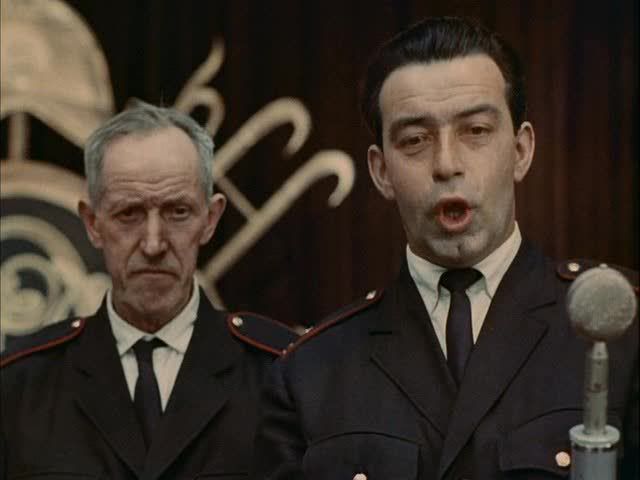
One of the characteristic features of this sequence, and the film as a whole, is the way that Forman frequently breaks down the body in shots that emphasize human movement and the awkward, messy exigencies of body-on-body contact in tight spaces. In this case, of course, the tight space is mainly the constriction of Forman's own frames, which are usually surrounding quite a few people. The next four shots are briskly edited together with lots of camera movement, as well as people moving very quickly within the shot. These shots are also mostly focused below the waist, with legs figuring in very heavily. Forman seems to have a fascination with women's legs that goes beyond mere sexualization. The focus on legs here is linked with the sequence's locomotive sensation, honing in on straining leg muscles and legs in various positions of flight and maneuvering. The scene might even be read, with some admitted stretching, in proto-feminist terms, whereby the legs that men viewed as sexual objects (the committee members got down to ground level in an earlier scene to check out the gams of prospective contestants) now become the means of flight from a demeaning beauty contest.

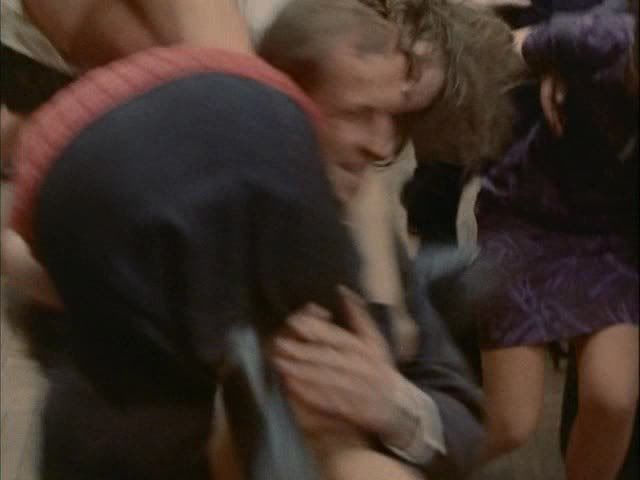
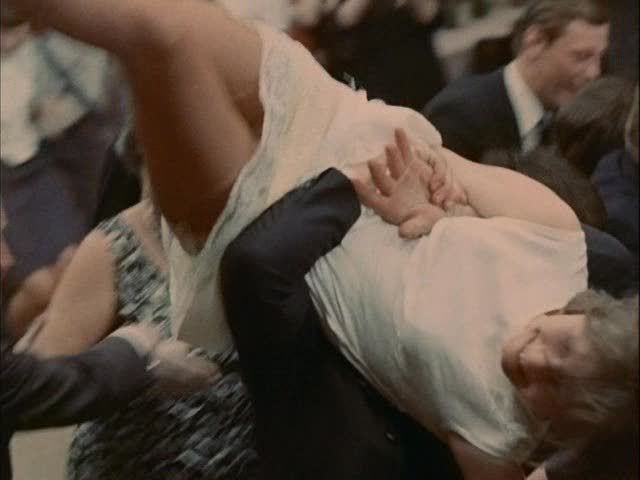

The next shot cuts back to the face of the one contestant who is actually standing on stage at this point, the first girl to go up, not because she was particularly bold or untroubled by the process, but because her father literally pushed her into it. These periodic cuts to the stage throughout this scene are moments of stasis, providing a contrast against the rowdiness of the crowd. This stasis is fleeting, though. As the scene goes by, the stage becomes less and less reliable as a source of safety from the rioting masses: the one contestant on stage makes her own flight from the pageant, the announcers finally give up and sit down, leaving the crown on the ground, and finally the rioters themselves take the stage, crowning one of their own in a triumphant end to the festivities.
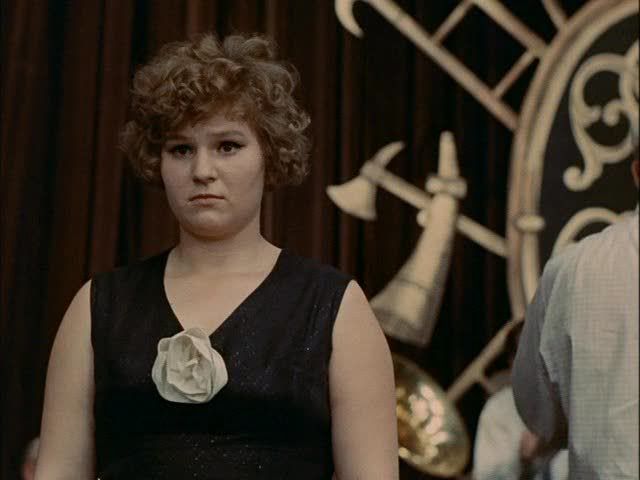
Forman next cuts back to the crowd, with a long shot of a group of guys lifting a laughing girl up onto a chair, followed by another close shot that emphasizes a woman's legs as she's carried around somewhat awkwardly.
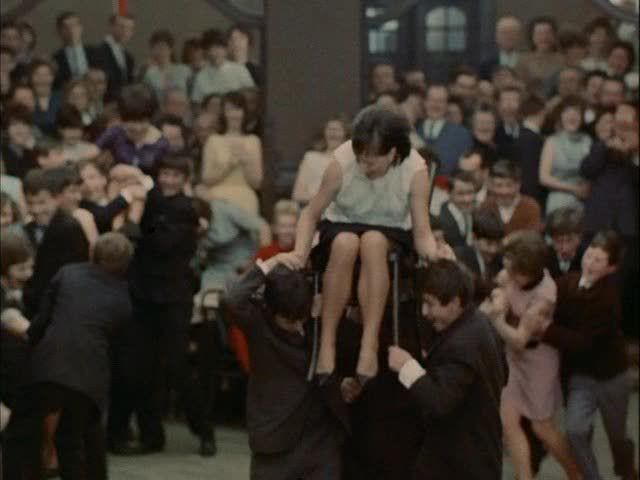
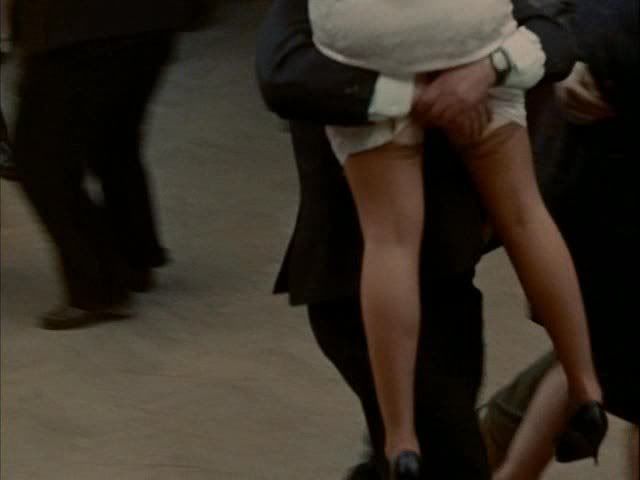
The camera cuts back to the increasingly frustrated announcers, who by now are getting tired of holding the crown aloft awaiting its recipients, and who are on the verge of giving up for good. The slightly low angle of these shots, and the grandiose decorations on the stage behind them, sets up these figures as sources of authority, clearly placed on a higher plane than the audience. The joke is that their supposed authority turns out to be empty flourishes, as the contestants refuse to obey them in coming up on stage, and they can't even get the band behind them to keep playing without taking a break for beer — an unfortunate pause in the music that unfortunately gave the contestants just the excuse they needed to break loose in the first place. This brief shot of authority collapsing into acquiescence is followed by another of the scene's characteristic shots of men and women scuffling in the crowd. These shots are taken from ground level, keeping them at the level of the rioters' legs, thus signaling the disparity between the higher authorities and the common people below them. In this particular shot, the two people in the foreground briefly clench, then come apart as the woman pushes the man to the floor, the camera shaking slightly downward, cutting off her head and focusing more on her legs as the man's fall is completed.
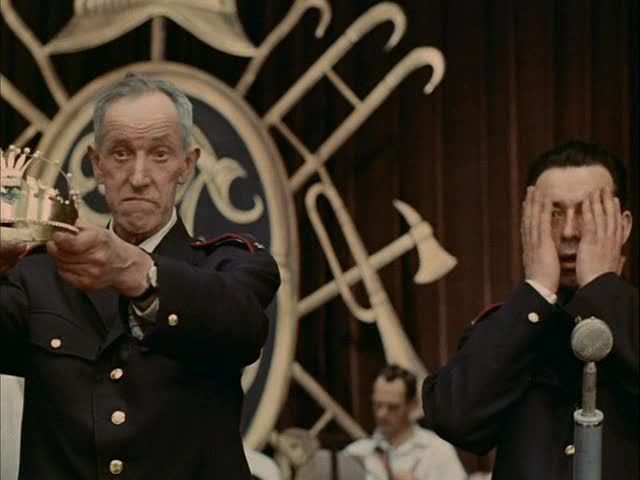
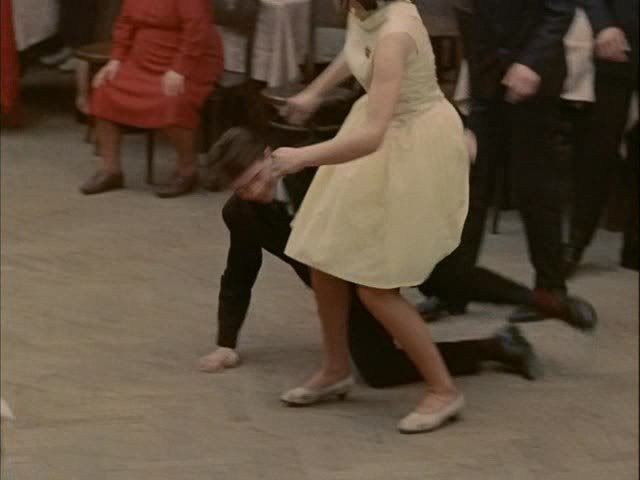
Forman's attention to legs is at times matched by the impression he gives of a sea of anonymous heads forming a monolithic crowd. Part of the film's critique of collective action is the way it captures the loss of individual identity in large masses, and the crowd scenes frequently point out and comment on this anti-individualist aspect of groups. It's easy to see this de-individualization in the many shots of legs, feet, and torsos, disconnected from their owners, but Forman's critique is every bit as implicit in the shots that show heads and faces. Even in these shots, individual people are given only fleeting representation, their faces glimpsed momentarily and then lost in the sea of undifferentiated bodies around them. Forman's frame is frequently obscured here by cloudbursts of frizzy hair and blurry, indistinct outlines of the revellers' heads. The occasional recognizable individual, like the laughing girl in the second shot below, seem to be peering out at the camera from a great distance, lost in the swirling, non-stop motion of her surrounding comrades.


Another subtextual undercurrent in this scene is the way in which Forman treats parts of the female body usually associated with sexualized depictions, especially when they're emphasized as much as they are here. In another film, it would be hard to view an extreme closeup of a woman's butt as anything other than the most blatant of sexual exploitation on the part of the director. Forman's perspective seems to be quite distinct from this crudely sexual viewpoint. Throughout the film he points out the sexualization of women's bodies in wry, ironical ways, not at all sympathizing with the leering gazes of the firemen but instead pointing out their objectification. During the scenes where the committee members are picking their contestants, Forman continually mocks the ways in which these ridiculous men size up the women like cattle. There's a hilarious scene where the men can't decide which part of the women's bodies to look at, so they first circle the ballroom ostentatiously staring at the girls' faces, then they go up on a balcony to check out bust sizes and cleavage, and finally they're crawling around on all fours at leg level. This tendency to ridicule the men for their libidinous gaze is carried over into the scene where they make the women line up in formation, barking orders at them, and finally make them march in circles. During this drill-like pageant preparation, Forman's camera drifts down to chest level, focusing on the breasts of the women as they circle in front of the camera's stationary position. This camera placement isn't meant to give the audience any gratification, but to draw attention to the perspective of the men who are watching this spectacle; Forman simply shows us what they're seeing.
The similar shots in the context of the riot scene are not as obviously satirical — there is no observing male viewpoint for Forman to mock in this case — but they nevertheless serve a similar purpose by drawing attention to the way that the men attempt to violently, forcefully round up the women for the pageant, as though they're herding animals rather than recruiting contestants. The focus on the women's physicality, as they gleefully avoid capture, thus emphasizes the parts of their bodies that invite male attention, while simultaneously subverting this attention with the overall thrust of the scene.

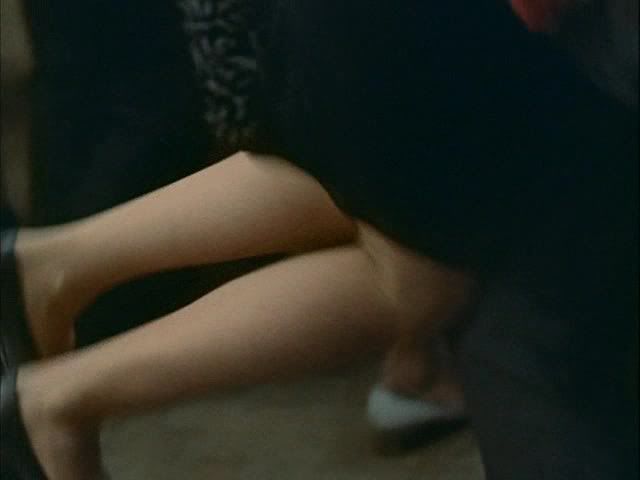
Continue reading this article with Part 2.
Monday, July 14, 2008
The Firemen's Ball: Two Visions of Collective Action
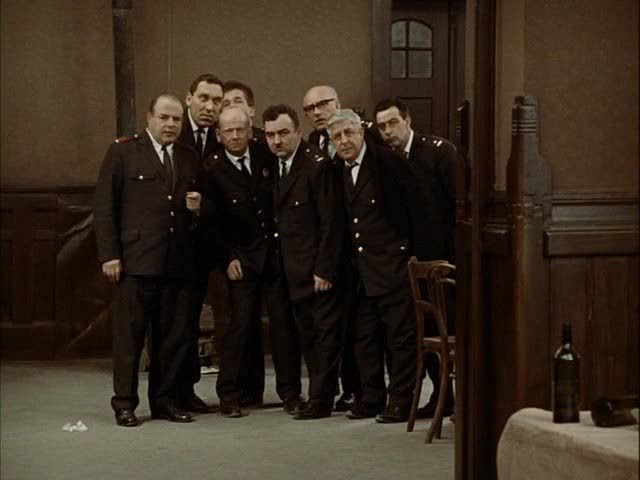
Made just before he left Czechoslovakia for the US, The Firemen's Ball was director Miloš Forman's first color film, his final film in his native country, and also the reason he had to leave his country in order to continue making films. It's easy to see why. The film is, quite obviously to both modern audiences and, apparently, Czech censors, a thinly veiled critique of the Czech Communist Party and, more audaciously, of the very idea of collective action that underpins socialism. This is a deadpan, hilarious satire, documenting a single night at a small-town party organized by the local fire brigade, honoring their retiring chairman on his eighty-sixth birthday (they missed honoring him on the more meaningful eighty-fifth, a year earlier, in the first of many fumbles committed by this incompetent assemblage). From the very beginning, even before the credits, Forman sets the scene for the idiocy to come, as the firemen accuse each other of stealing the prizes from the night's lottery fund, and set fire to the banner that was to hang above the hall during the ball. The fact that they're unable to even operate the equipment to put out this small-scale blaze is both the first comment on the extent of their incompetence and a bit of foreshadowing for the film's surprisingly poignant climax.
Of course, things only get worse from here. These are men who can manage to screw up the process of selecting beauty contest participants in what seems to be a ballroom positively crammed with attractive young women. Their chosen finalists are either aggressively plain or exaggeratedly awkward, like the girl who pads her bra to such an extent that her dress seems to be held away from her body on tent posts. Forman simply lets absurd scenarios like this play out in natural ways, sticking with this anonymous and ridiculous committee as they bungle their way through every aspect of the party's planning. Over the course of the evening, the table piled high with lottery gifts is slowly emptied by multiple (and unseen) thieveries, young couples copulate under tables, the chairman seems senile and lost, and keeps executing a slow, stately walk towards the stage at completely inappropriate moments, and the beauty contest itself falls apart, in one of the film's most hysterical scenes, when the contestants all get cold feet and begin fleeing.
Forman stages all this in an atmosphere of rapidly escalating chaos, as the party spirals completely out of control. His camera is intimate, casual, and perfectly attuned to the spirit of anarchic insanity running throughout this room. Indeed, Forman often seems to be taking gleeful pleasure in the lunacy going on everywhere. His mise en scène encompasses, essentially, two different visions of collectivity: the ordered committee action of the party organizers, and the wild, unfettered anarchy of the party itself. For Forman, both of these possible outcomes are equally absurd, and both are clearly tied to aspects of Communist society — just as the fire brigade stand in for the Communist Politburo, the partygoers are the proletariat, trapped within an absurd situation with absurd leaders, and forced by these circumstances to act in dishonest and despicable ways. This is a system that privileges dishonesty. Confronted with the fact that all the lottery prizes have been stolen, the fire committee decides that the people who didn't steal will just have to think of it as if there was a lottery and they didn't win. After all, everyone bought tickets; those who stole the prizes were simply the winners. When one of the committee members has an unusual attack of guilt and is caught attempting to return a stolen prize, his comrades are angry at him, not for stealing (that's expected), but for trying to return the prize, thus damaging the reputation of the fire brigade.
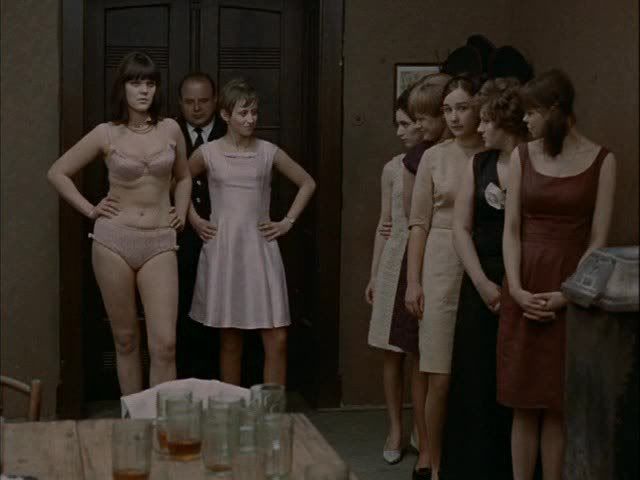
Forman's framing of the fire brigade inevitably enforces the point that they are nominally in charge but crippled by their indecisiveness, incompetence, and corruption. The group is almost always photographed together, seldom with the members isolated from one another for any length of time — the exception is when the one member has his moment of repentance. Most of them are not even given names. They are anonymous figureheads, an idealized group that acts together with no trace of individuality. Or so goes the Communist theory, Forman seems to be saying wryly. In practice, his head-on depictions of these men, massed into groups, projects an image exactly the opposite of the unity and collective action that is the ideal of socialist politics. As they cluster into tight formations, staring tentatively and fearfully at the camera, they look lost, like scared individuals trying to hide within the safety of a larger group. Forman's perspective, his deadpan camera angles and his objective distance from the assembled old men, gives them a pathetic quality that's heightened, not lessened, by their collectivity. It's this subversive questioning of collective action that is most radical in Forman's film, and is probably what the Czech censors responded to the most ferociously, even if it only registered with them subconsciously.
Not that "the people" make out any better here. The leadership may be idiotic, but the people they're leading are stubborn, unwilling to be led, and forthrightly dishonest. If Forman's vision of committee leadership is marked by its static angles and clustered compositions, his party scenes have a wildness and spontaneity that presents the reverse of this rigidly absurd group leadership. These scenes are chaotic accumulations of bodies whirling and flying past, often broken down so that only body parts can be seen. Individual shots focus on the legs of the dancers, or their arms and torsos in the midst of a frenetic riot, or their amassed heads in a sea as they listen to a speaker on stage. Best of all is the complete breakdown of order that accompanies the beauty contest, as the contestants run away and the crowd quickly degenerates into chaos, with crowds of guys attempting to corner the women and drag them on stage, throwing girls over their shoulders, even roping in girls who hadn't been in the contest to begin with. It's a masterpiece of completely unrestrained society, "the people" breaking loose of their inept masters and having fun watching the destruction of their social order. But Forman's editing in this scene is also surprisingly crisp, his images maintaining the perfect economy of his more structured compositions even when the stampeding revelers seem to be disrupting any semblance of order. Forman's portrait of disorder is perfectly conceived, achieved with a natural sense for visual rhythms and purely visual humor.
The Firemen's Ball is a delightful film, but also a film with a very serious heart beating beneath its surface humor. As the film's climax reveals, the incompetence of the fire brigade, which seems so comical in the context of a disastrous party, can also have serious consequences when applied to real world matters. When these bumblers are placed in charge of not a beauty contest but of public safety, the true extent of their bumbling, and its horrifying results, becomes readily apparent. This is why the sequence of the old man's house burning, placed where it is within the film, is so heartrending. As Forman cuts precisely back and forth between shots of the consuming, brilliant fire and the emotional faces of the observing crowd, the hopeless non-efforts of the firemen to extinguish this blaze are not funny, but incredibly depressing. The same could be said of the later scene where the committee members even bungle the presentation of an award to their former chairman, who is now dying of cancer. This old man's quiet dignity and patience in the face of the evening's many disasters make a mockery of the committee's ham-fisted attempts to honor him. A decent man in a corrupt system, he is entirely out of place here, and he becomes a victim as a result. This is a hilarious film, but its humor is cut with bitter satire, with a deep disgust for the absurdities of the political system of Czechoslovakia at the time.
Sunday, July 13, 2008
I Laugh at Danger! Milos Forman and The Firemen's Ball
 by Marilyn Ferdinand
by Marilyn FerdinandI went to my dentist's yesterday. I’ve been seeing Dr. Hamilton for more than 25 years and always assumed from his accent and attire that he was German. I got a real surprise when he revealed that he was Czech and had grown up in Prague, a couple of blocks from the old city square, just around the corner from where Franz Kafka grew up. Naturally, I couldn’t believe the serendipity of learning my long-time dentist was Czech on the same day I planned to write my FOTM Club post on The Firemen’s Ball. We talked about Miloš Forman, and Dr. Hamilton related some fascinating film and moviegoing experiences he had had in Czechoslovakia. He said he had a great story for me:
There used to be a tank on a pedestal in Prague that was supposed to have been the first Soviet tank to move into the city to liberate it from the Nazis. “Naturally,” Dr. Hamilton said, “It was a propaganda lie. The Czechs rose up against the occupying Germans as Berlin was falling and drove them out themselves.” When he went back to Prague after a 25-year absence, he asked his cab driver if the tank was still there. “Oh no, that’s long gone,” the cabbie said. When the Communists were falling, the Czech citizens stole into the night and painted the tank pink. The Russians were so embarrassed, they took it down—pedestal and all!
I couldn’t have had a better picture of the Czech spirit, as explicitly captured in The Firemen’s Ball, if I painted it myself.
The Firemen’s Ball was the last film—and the only color film—Forman made in Czechoslovakia. The warm reception of his second full-length feature, The Loves of a Blonde, helped convince producer Carlo Ponti to provide the financing that made color shooting possible. Forman and his creative partners, Ivan Passer and Jaroslav Papousek, holed up in a small Czech town to concentrate on writing the screenplay. After days of producing one bad scenario after another, the men decided to relax their minds at a firemen’s ball being held in the town that weekend. Afterwards, the ball was all they could talk about. Thus, The Firemen’s Ball was inevitable, and they were able to enlist many of the actual firemen and people in the town to appear in the movie.
When Ponti saw the film, he hated it so much that he exercised his right under his contract with the Czechoslovakian government to have his $65,000 returned. Forman faced 10 years in prison if he could not pay the government back; fortunately, he was able to show the film to Claude Berri and Francois Truffaut, and they paid his debt. Nonetheless, the government banned the film; it was unbanned for a few months in 1968 when Alexander Dubček came to power and then rebanned forever from its native screens—how absurdly Czech!
What was it about this film that Ponti and even the more relaxed Communist government of the 1960s so despised? It made fun of the proletariat! While there’s no question that the Czech people come in for some ribbing—donating raffle tickets for odd prizes that are slowly disappearing from a “guarded” table to a man who has just lost his home in a fire—the disorganized system of committee rule and the obedient functionaries of Communism are the main targets.
It’s not hard to see how the board of the firemen’s association is a stand-in for the Politburo that can’t bring order to chaos or basic goods and services to the people. Along with the party goers, we watch “Granddad’s” home blacken and burn because the fire truck is stuck in the snow; meanwhile, the capitalist ballroom owner walks through the crowd collecting on bar tabs and sets up a table from which to continue to sell drinks.
I am perhaps most intrigued by the 86-year-old former chairman of the firemen’s association who is to receive an award—a miniature, engraved axe—for his dedicated service over the years. It is to be presented by the winner of an impromptu beauty contest that, due to its runaway contestants, never takes place. The old man starts a straight, dignified walk toward the stage as the first contestant is called. He must be called back. He sits. He waits patiently as one disaster after another befalls the committee and the ball. At the very end, he alone remains in the trash-strewn ballroom. The committee hastily retrieves the box containing the award and decides to present it themselves. The old man moves forward, takes the box, and recites his carefully prepared and somewhat lengthy speech. When he opens the box, he finds the axe has been pilfered, too.
This old man is something of an enigma to me. He’s certainly the loyal Communist who comes up empty-handed in the end because of the of the system’s misshapen supply-demand curve. He’s also a leader blind to everything but his own role, the perfect bureaucrat in a broken chain, as well as a man (system) who is dying of cancer who has not been told he is ill. Finally, of course, he is an ordinary citizen who is degraded by the petty thievery of an item that can mean nothing to anyone else. This theft is both humorous—a raspberry in the face of the leadership—and a sad way for a fellow human being to be treated. Despite its high comedy, it’s no wonder the film has been called highly pessimistic.
The contemporary film movements from former Soviet Bloc countries—particularly Romania and Bosnia—identify with their traumas and open their veins. The Firemen’s Ball, though pessimistic, reflects the Czech sensibility characterized by an appreciation for the absurd, a howl of laughter in the face of danger. Forman, the only member of the Czech New Wave to have a highly successful career outside of his home country, has focused on some of his early concerns in other films (One Flew Over the Cuckoo’s Nest, Ragtime, The People vs. Larry Flynt) but without the giggles. I hope Forman finds a tank in the near future that needs a new coat of paint.
Wednesday, July 9, 2008
July's Film of the Month
 Hello, FOTM club members and interested readers. Marilyn from Ferdy on Films, etc. here. The club has been a bit sparse for participation this summer—yes, we’d all rather be enjoying the summer (at outdoor film venues, perhaps?)—but the club meetings march on. Chris has asked me to pick the film for this later-than-usual start for the film of the month. I’ve chosen a film I haven’t seen but that will help with the survey I’m currently doing of the works of Milos Forman, namely, The Firemen’s Ball. My interest stems from a retro Facets Multimedia had of Forman’s Czech films and my own continuing interest in films from the Balkan/Soviet Bloc region. I’m not well versed in films of the Czech New Wave, so I hope to broaden my knowledge of this movement. I hope club members with knowledge in this area will step up with what they know. For a good overview of the Czech New Wave, read Andrew James Horton’s primer at GreenCine.
Hello, FOTM club members and interested readers. Marilyn from Ferdy on Films, etc. here. The club has been a bit sparse for participation this summer—yes, we’d all rather be enjoying the summer (at outdoor film venues, perhaps?)—but the club meetings march on. Chris has asked me to pick the film for this later-than-usual start for the film of the month. I’ve chosen a film I haven’t seen but that will help with the survey I’m currently doing of the works of Milos Forman, namely, The Firemen’s Ball. My interest stems from a retro Facets Multimedia had of Forman’s Czech films and my own continuing interest in films from the Balkan/Soviet Bloc region. I’m not well versed in films of the Czech New Wave, so I hope to broaden my knowledge of this movement. I hope club members with knowledge in this area will step up with what they know. For a good overview of the Czech New Wave, read Andrew James Horton’s primer at GreenCine.




